Connecticut is a small state on the south coast of the United States and is uniquely located on the Long Island Sound. Connecticut has some diverse habitats from its coastal regions to the Connecticut River Valley. There are hundreds of animals that call the state home both on the land and in the water, including bears, snakes, whales, and birds. But just how big can these animals get? Join us as we discover the largest animals in Connecticut, and where you’ll find them!
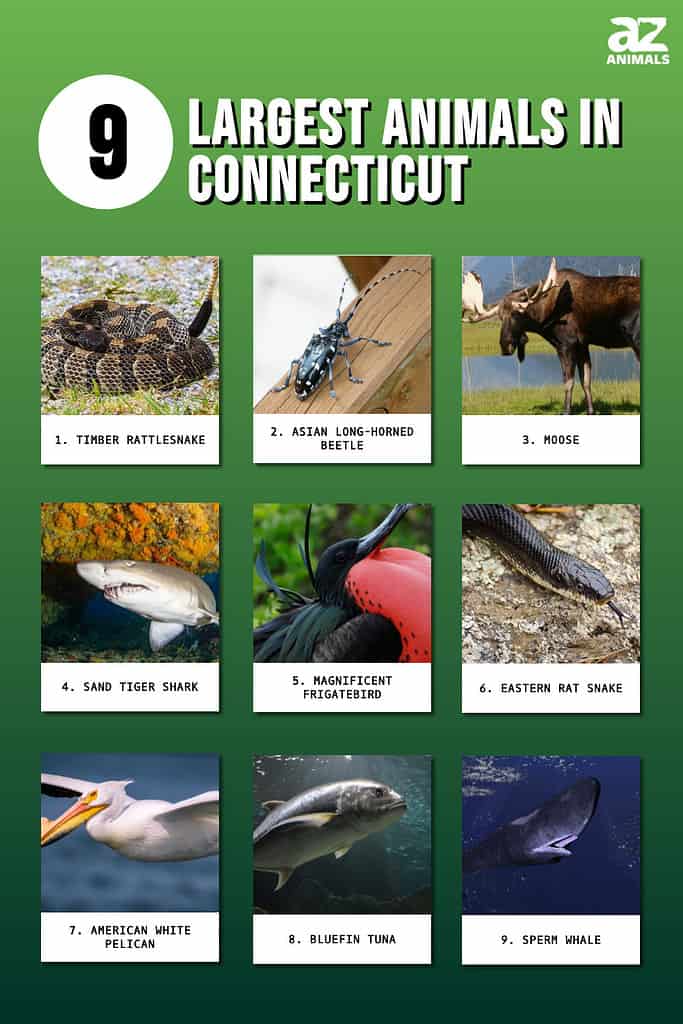
9. Timber Rattlesnake

Timber
rattlesnakes
averages about 5 feet long.
©Frode Jacobsen/Shutterstock.com
There are two venomous snakes in Connecticut and the largest is the timber rattlesnake, which reaches approximately 5 feet long. Timber rattlesnakes are yellowish brown and have dark brown or black crossband markings on their bodies. They usually prefer to live in forest regions, although pregnant females often reside on rocky outcrops that are known as “basking knolls.” Timber rattlesnakes are not widespread through Connecticut and only live in the Meshomasic State Forest and in the northwest region of Litchfield County. Although they are one of the most dangerous snakes in the entire U.S., timber rattlesnakes rarely strike unless they are threatened.
8. Asian Long-Horned Beetle
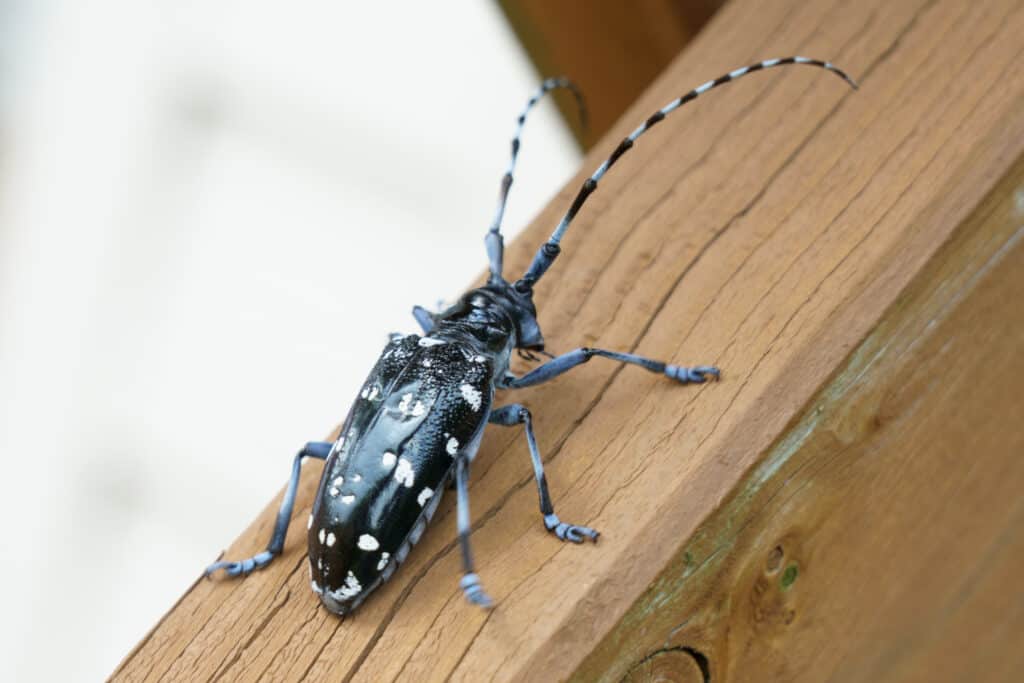
Asian long-horned beetles are highly destructive to trees and are often classed as pests.
©High Mountain/Shutterstock.com
Beetles are some of the largest insects in Connecticut and the Asian long-horned beetle is an invasive pest that reaches around 1.5 inches long. Asian long-horned beetles are native to China and Korea but were first discovered in the U.S. in 1996. As their name suggests, they have extremely long antennas that can be up to twice the length of their bodies. Asian long-horned beetles live in forests where they can be extremely destructive to trees. This is because they bore into the wood of living or freshly felled trees to feed on the wood and plant material, often with devastating consequences to the trees.
7. Moose
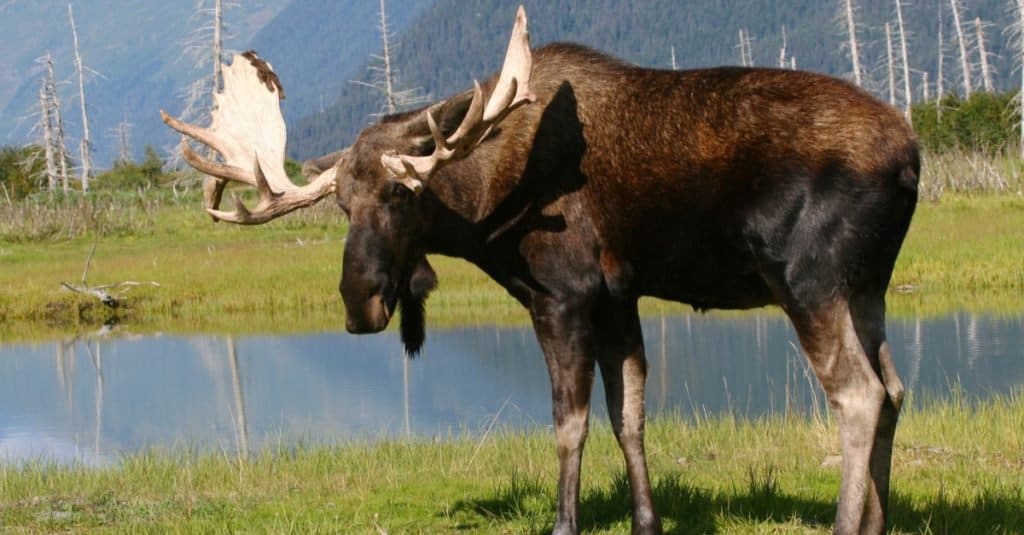
The moose is one of the largest animals in Connecticut and can weigh up to 1,800 pounds.
©Steve Bower/Shutterstock.com
One of the largest animals in Connecticut is undoubtedly the massive moose, which is the largest member of the deer family. Moose stand 4 feet 7 inches to 6 feet 11 inches at the shoulder and can weigh up to a maximum reported size of 1,800 pounds. These huge animals typically inhabit forests across North America. However, they are not widespread in Connecticut and the current population is estimated at only 100 individuals. This is the eastern moose subspecies that has slowly expanded its range into the state. As the numbers are so low, it is illegal to hunt or kill moose in Connecticut.
6. Sand Tiger Shark
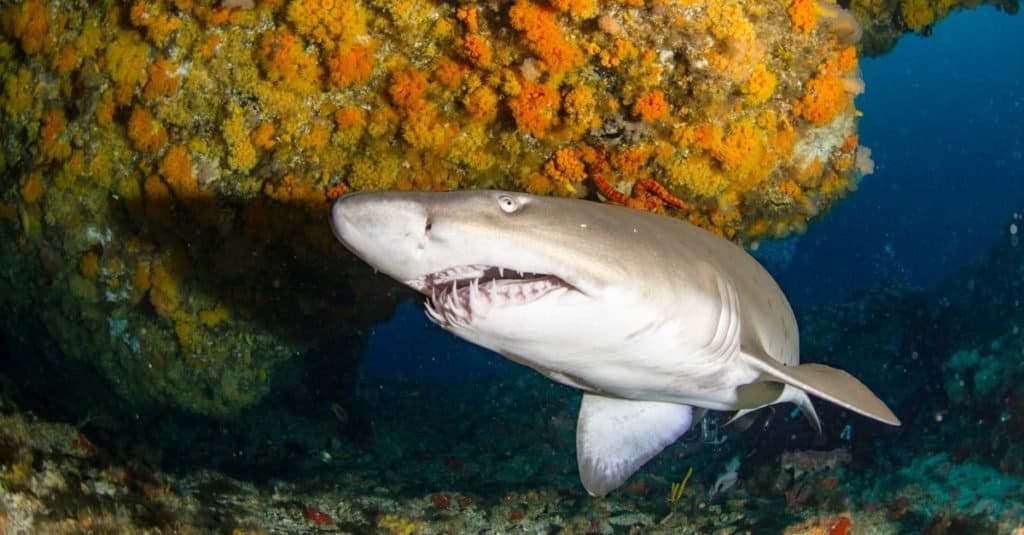
Sand
tiger
sharks, which can grow up to 10 feet long, are critically endangered.
©Stefan Pircher/Shutterstock.com
Although there has been a great white shark spotted in Connecticut waters, they do not regularly visit the area. Instead, one of the largest fish in Connecticut is the sand tiger shark, which reaches approximately 10 feet long. Sand tiger sharks have a stocky body and a particularly pointy and flattened snout with a mouth that extends beyond their eyes. They often swim with their mouth open, displaying their many rows of sharp teeth that often give them a reputation for being dangerous. However, they are not particularly aggressive and do not usually threaten humans. They are critically endangered, mainly because of their slow reproduction rate as they only produce two pups every two to three years. Although their numbers are low, one of the best places to see them in Connecticut is near Silver Sands State Park.
5. Magnificent Frigatebird
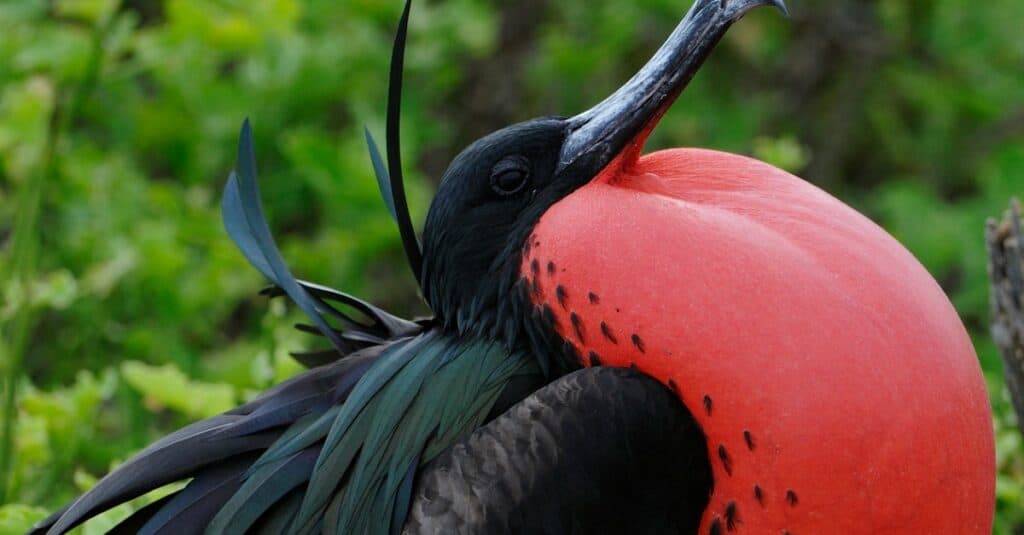
The male magnificent frigatebird is recognized for having the longest wingspan of any bird.
©iStock.com/Clay Clark
Easily, the most stunning bird in Connecticut is the magnificent frigatebird found only in the state outside of the breeding season. Magnificent frigatebirds have slight bodies but a massive wingspan of 7 to 8 feet. Both males and females typically have black feathers and the females have a white neck and breast with brown on their wings. However, males have a scarlet throat pouch that inflates during the breeding season so that they can attract a mate. Magnificent frigatebirds are seabirds and nest along tropical and subtropical coastlines and prey on fish, squid, and crustaceans.
4. Eastern Rat Snake

Eastern rat snakes are large, nonvenomous snakes that regularly reach 6 feet in length.
©iStock.com/RCKeller
The longest snake in Connecticut is the eastern rat snake, which regularly reaches 6 feet long, with some individuals reported to exceed 7 feet. Eastern rat snakes are nonvenomous constrictors that prey on a wide range of lizards, birds, rodents, and frogs. Their color can vary but most are black with white chins, lips, and throats. Their dorsal scales are keeled but for the most part they have a bright and shiny appearance. Eastern rat snakes are highly adaptable and live in a variety of habitats, including farmland, forests, and wetlands. In Connecticut, they inhabit the coastal regions and the southeastern hills — from New Haven to Rhode Island — and the southwestern hills to Litchfield County.
3. American White Pelican
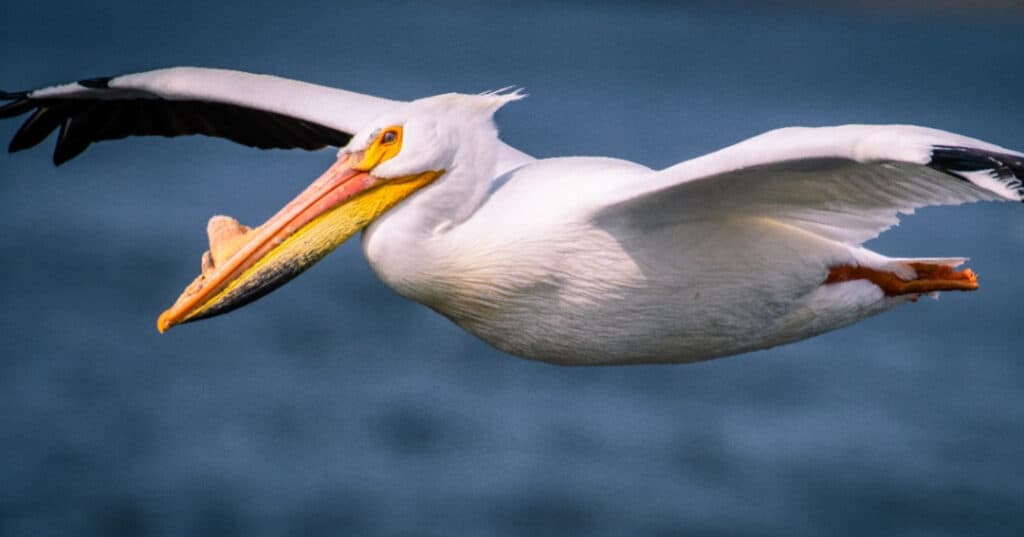
American white pelicans are distinguished for their long bill and incredible 9-foot wingspan.
©Jerek Vaughn/Shutterstock.com
Easily one of the largest animals in Connecticut is the huge American white pelican, which has a massive 9-foot wingspan. These birds are easily distinguished by their bright white plumage and long, flat bill. American white pelicans live near lakes and coastlines and typically visit Connecticut during the winter months. They nest in large colonies that can consist of as many as 5,000 breeding pairs. Nests are simply shallow depressions on the ground lined with twigs. Both parents incubate the eggs and care for the subsequent chicks.
2. Bluefin Tuna
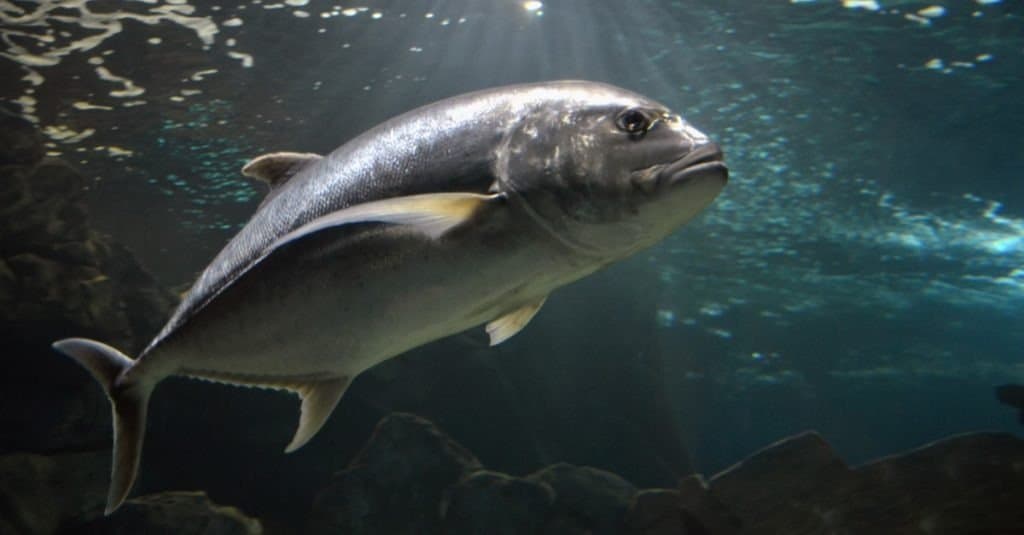
Bluefin tuna can grow to 14 feet long and weigh as much as 2,000 pounds.
©jurgal photographer/Shutterstock.com
One of the most stunning and powerful fish in the waters around Connecticut is the massive bluefin tuna. They can reach approximately 14 feet long and weigh as much as 2,000 pounds. These massive fish have torpedo-shaped bodies and are dark blue on their upper sides and silvery grey on their lower sides. Blue fin tuna reach an incredible speed of 50 mph, something which makes them particularly sought after by sport fishermen. They have few natural predators and they themselves prey on a wide range of fish, octopus, and crabs. Bluefin tuna are native to the Atlantic Ocean and the Mediterranean Sea and can regularly be found in the waters around Connecticut.
1. Sperm Whale

The sperm whale, which can reach an immense 59 feet long, is Connecticut’s state animal.
©bekirevren/Shutterstock.com
The largest animal in Connecticut is the huge sperm whale. Sperm whales are the largest of all of the toothed whales. They can reach an immense 59 feet long, with males being larger than females. Sperm whales are some of the deepest diving animals in the world and can reach depths of up to 7,380 feet deep. They are found in most oceans around the world. However, although they are the Connecticut state animal, they are actually now extremely rare in the state, given their status as a vulnerable species. Sperm whales are fascinating animals and live in large matriarchal pods. They have few natural predators, with orcas being the only real threat to young, ill, or injured sperm whales.
Summary of the 9 Largest Animals in Connecticut, and Where You’ll Find Them
Here’s a recap of the nine biggest animals found in Connecticut that we took a look at.
| Number | Animal | Size | Range in Connecticut |
|---|---|---|---|
| 1 | Sperm Whale | Can reach an immense 59 feet long; males are larger than females | Extremely rare in the state |
| 2 | Bluefin Tuna | Length: About 14 feet long; Weight: up to 2,000 pounds | Regularly found in waters around Connecticut |
| 3 | American White Pelican | 9-foot wingspan | Live near lakes and coastlines; typically visit during winter |
| 4 | Eastern Rat Snake | Regularly reach 6 feet long; some reported to exceed 7 feet | Coastal regions and southeastern hills (from New Haven to Rhode Island) and the southwestern hills to Litchfield County |
| 5 | Magnificent Frigatebird | 7 to 8-foot wingspan | In the state outside of the breeding season |
| 6 | Sand Tiger Shark | Grows around 10 feet long | Low numbers; best seen near Silver Sands State Park |
| 7 | Moose | Height: 4 feet 7 inches to 6 feet 11 inches at the shoulder; Weight: 1,800 pounds | Widespread in Connecticut |
| 8 | Asian Long-Horned Beetle | Reaches around 1.5 inches long; antennas can be up to twice the length of their bodies | Forests, where they can be extremely destructive to trees |
| 9 | Timber Rattlesnake | Grows approximately 5 feet long | Not widespread; only live in the Meshomasic State Forest and in the northwest region of Litchfield County |
The photo featured at the top of this post is © wildestanimal/Shutterstock.com
Thank you for reading! Have some feedback for us? Contact the AZ Animals editorial team.






